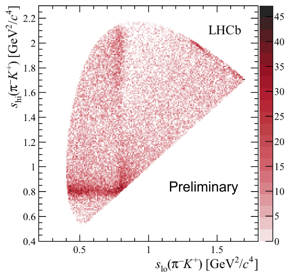Charm Physics
Last Update: April 8, 2019
Charm Physics
Charm physics covers the studies of particles containing a charm-quark. In our group we are interested in the decays of the mesons D+(-) and Ds+(-). The D+ is composed of a charm quark (c) and a down antiquark (d), while the D- is composed of a charm antiquark (c) and a down quark (d). The Ds+ is composed of a charm quark (c) and a strange antiquark (s), while the D- is composed of a charm antiquark (c) and a strange quark (s).
The decays of D+(-) and Ds+(-) into 3 charged hadrons are a good laboratory for the study of hadronic physics and CP violation. In our studies, we use the large samples of charm mesons produced in the proton-proton collisions at the Large Hadron Collider and collected by the LHCb experiment.
The LHCb charm group from Rio is composed of people from LAPE/IF-UFRJ, from CBPF and from PUC-Rio.
Ds+→ h-h+h+ Group Members :
Erica Polycarpo (LAPE/IF-UFRJ)
Sandra Amato (LAPE/IF-UFRJ)
Alberto Reis (CBPF)
Carla Göbel (PUC-Rio)
Graduate Students:
Felipe L. Souza de Almeida (PhD-IF/UFRJ)
Juan Leite (MSc – CBPF)
Fernanda Gonçalves Abrantes (MSc – PUC-Rio)
Murillo Vellasco (MSc – PUC-Rio)
PUBLICATIONS (under our direct responsability):
- Measurement of the branching fractions of the decays D+→K-K+K+, D+→π-π-K+ and Ds+→π-K-K+
- Dalitz plot analysis of the decays D+→K-K+K+
- Search for CP violation in the decay D+→π-π+π+
- Search for CP violation in D+→K-K+π+ decays
Charm News
- 08/04/2019: Dalitz plot analysis of the D+→K-K+K+ decay published in JHEP 04 (2019) 063
- 27/03/2019: Measurement of the branching fractions of the decays D+→K-K+K+, D+→π-π-K+ and Ds+→π-K-K+ published in JHEP03(2019)176

- 21/03/2019: First observation of CP violation in the charm sector (See in Portuguese)
- 27/09/2018: The LHCb Collaboration shows today in its outreach web page the results of 3 analyses which have been presented for the first time in CKM 2018. Among these results, the measurements of the branching fractions of rare decays of charmed mesons have been proposed and performed by members of LAPE (Sandra Amato, Erica Polycarpo and the undergrad student Felipe L.S. de Almeida ), CBPF (Alberto Reis) e PUC-Rio (Carla Göbel). See the LHCb outreach page for the original text.

The distribution of Ds+→π-K+K+ candidates across the Dalitz plot is shown in the image, where the presence of intermediate particles (resonances) in the decays can be identified as highly populated regions or bands. Numerical values can be found in the LHCb presentation and in the LHCb paper, and are the most precise results obtained for these decays up to date.

